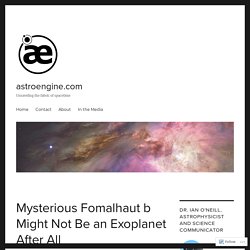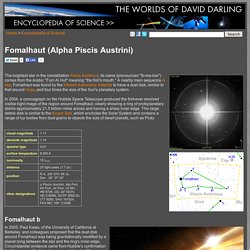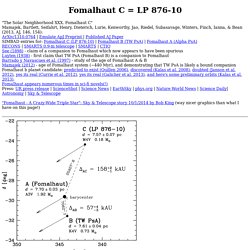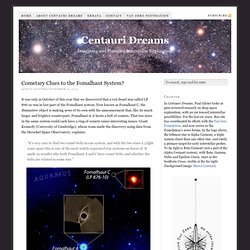

Dagon not a planet at all? The famous exoplanet was the first to be directly imaged by Hubble in 2008 but many mysteries surround its identity — so astronomers are testing the possibility that it might actually be an exotic neutron star.

Located 25 light-years from Earth, the bright star Fomalhaut is quite the celebrity. As part of a triple star system (its distant, yet gravitationally bound siblings are orange dwarf TW Piscis Austrini and M-type red dwarf LP 876-10) Fomalhaut is filled with an impressive field of debris, sharing a likeness with the Lord Of The Rings’ “Eye of Sauron.” And, in 2008, the eerie star system shot to fame as the host of the first ever directly-imaged exoplanet. This was a big deal. Not only was it the first direct observation of a world orbiting another star, Hubble was the aging space telescope that found it. Fomalhaut b was detected in visible and near-infrared wavelengths, but followup studies in other wavelengths revealed some peculiarities. Like this: Like Loading... Related. In Browning.
Another painting here. The brightest star in the constellation Piscis Austrinus; its name (pronounced "fo-ma-low") comes from the Arabic "Fum Al Hut" meaning "the fish's mouth.

" A nearby main sequence A star, Fomalhaut was found by the Infrared Astronomy Satellite to have a dust disk, similar to that around Vega, and four times the size of the Sun's planetary system. In 2004, a coronagraph on the Hubble Space Telescope produced the first-ever resolved visible-light image of the region around Fomalhaut, clearly showing a ring of protoplanetary debris approximately 21.5 billion miles across and having a sharp inner edge.
This large debris disk is similar to the Kuiper Belt, which encircles the Solar System and contains a range of icy bodies from dust grains to objects the size of dwarf planets, such as Pluto. Fomalhaut b Fomalhaut is only about 200 million years old and may offer a glimpse of what our own Solar System was like some 4.3 billion years ago. Related entry • brightest stars Related category NASA/Hubble. LP 876-10 = Fomalhaut C. "The Solar Neighborhood XXX.

Fomalhaut C" Mamajek, Bartlett, Seifahrt, Henry, Dieterich, Lurie, Kenworthy, Jao, Riedel, Subasavage, Winters, Finch, Ianna, & Bean (2013, AJ, 146, 154): ArXiv/1310.0764 | Emulate ApJ Preprint | Published AJ Paper SIMBAD entries for: Fomalhaut C (LP 876-10) | Fomalhaut B (TW PsA) | Fomalhaut A (Alpha PsA) RECONS | SMARTS 0.9-m telescope | SMARTS | CTIO See (1898) - claim of a companion to Fomalhaut which now appears to have been spuriousLuyten (1938) - first claim that TW PsA (Fomalhaut B) is a companion to FomalhautBarrado y Navascues et al. (1997) - study of the age of Fomalhaut A & BMamajek (2012) - age of Fomalhaut system (~440 Myr), and demonstrating that TW PsA is likely a bound companion Fomalhaut b planet candidate: predicted to exist (Quillen 2006), discovered (Kalas et al. 2008), doubted (Janson et al. 2012), yes its real (Currie et al. 2012), yes its real (Galicher et al. 2013), and here's some preliminary orbits (Kalas et al. 2013).
Fomalhaut C. It was only in October of this year that we discovered that a red dwarf star called LP 876-10 was in fact part of the Fomalhaut system.

Now known as Fomalhaut C, the diminutive object is making news of its own with the announcement that, like its much larger and brighter counterpart, Fomalhaut A, it hosts a belt of comets. That two stars in the same system could each have a ring of comets raises interesting issues. Grant Kennedy (University of Cambridge), whose team made the discovery using data from the Herschel Space Observatory, explains: “It’s very rare to find two comet belts in one system, and with the two stars 2.5 light years apart this is one of the most widely separated star systems we know of. It made us wonder why both Fomalhaut A and C have comet belts, and whether the belts are related in some way.” Naming fomalhaut b. Do not experience rains and winds, how see rainbow, no one can casually succeed!
Looks like this website has suffered an unspeakable, clearly lovecraftian fate...well, the planet is now known as DAGON, anyways... – graywyvern
Come on!

New Year more different! Cthugha animated. The animation is based on two papers: the Fomalhaut b discovery paper by Kalas, Graham, Chiang, et al. (2008, Science) and the companion theory paper by Chiang, Kite, Kalas, Graham, & Clampin (2009, The Astrophysical Journal, in press).

Fomalhaut b is the first extrasolar planet to be directly imaged at visible wavelengths and to have its orbital motion around its host star measured (Kalas et al. 2008). The Fomalhaut system might also present the first example of planet-disk interaction during a formative era. This interaction is the subject of the animation. Over hundreds of millions of years, Fomalhaut b gravitationally ejects bodies from its immediate vicinity. It scours its so-called chaotic zone (Quillen 2006). The realization that the belt edge is located at the periphery of the planet's chaotic zone led Quillen (2006) to predict that a planet would be found orbiting just interior to the belt, with an orbital semimajor axis of 119 AU. The loneliest star. The star Fomalhaut – an autumn star for the Northern Hemisphere, sometimes called the Loneliest Star – holds a special place in the search for planets beyond our solar system.

Orbiting Fomalhaut is the first extrasolar planet visible to the eye in photographic images. By 2008, when Fomalhaut’s planet became visible, we knew other planets were out there, orbiting distant suns.